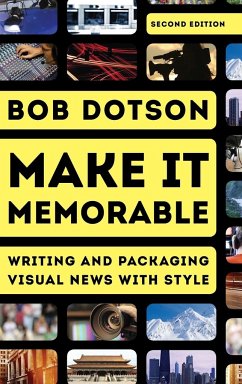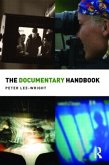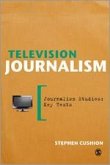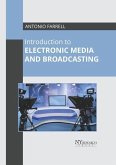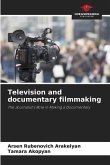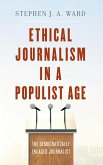- Gebundenes Buch
- Merkliste
- Auf die Merkliste
- Bewerten Bewerten
- Teilen
- Produkt teilen
- Produkterinnerung
- Produkterinnerung
A nuts-and-bolts guide to the craft of visual storytelling, written for students and up-and-coming journalists by one of the country's best-loved news correspondents.
Andere Kunden interessierten sich auch für
![The Documentary Handbook The Documentary Handbook]() Peter Lee-WrightThe Documentary Handbook78,99 €
Peter Lee-WrightThe Documentary Handbook78,99 €![Television Journalism Television Journalism]() Stephen CushionTelevision Journalism68,99 €
Stephen CushionTelevision Journalism68,99 €![Introduction to Electronic Media and Broadcasting Introduction to Electronic Media and Broadcasting]() Introduction to Electronic Media and Broadcasting160,99 €
Introduction to Electronic Media and Broadcasting160,99 €![Television and documentary filmmaking Television and documentary filmmaking]() Arsen Rubenovich ArakelyanTelevision and documentary filmmaking18,99 €
Arsen Rubenovich ArakelyanTelevision and documentary filmmaking18,99 €![Power Without Responsibility Power Without Responsibility]() James CurranPower Without Responsibility194,99 €
James CurranPower Without Responsibility194,99 €![The Thematic Evolution of Sports Journalism's Narrative of Mental Illness The Thematic Evolution of Sports Journalism's Narrative of Mental Illness]() Ronald BishopThe Thematic Evolution of Sports Journalism's Narrative of Mental Illness140,99 €
Ronald BishopThe Thematic Evolution of Sports Journalism's Narrative of Mental Illness140,99 €![Ethical Journalism in a Populist Age Ethical Journalism in a Populist Age]() Stephen J. A. WardEthical Journalism in a Populist Age91,99 €
Stephen J. A. WardEthical Journalism in a Populist Age91,99 €-
-
-
A nuts-and-bolts guide to the craft of visual storytelling, written for students and up-and-coming journalists by one of the country's best-loved news correspondents.
Hinweis: Dieser Artikel kann nur an eine deutsche Lieferadresse ausgeliefert werden.
Hinweis: Dieser Artikel kann nur an eine deutsche Lieferadresse ausgeliefert werden.
Produktdetails
- Produktdetails
- Verlag: RLPG/Galleys
- Second Edition
- Seitenzahl: 158
- Erscheinungstermin: 16. Oktober 2015
- Englisch
- Abmessung: 235mm x 157mm x 13mm
- Gewicht: 389g
- ISBN-13: 9781442256101
- ISBN-10: 1442256109
- Artikelnr.: 43043661
- Herstellerkennzeichnung
- Libri GmbH
- Europaallee 1
- 36244 Bad Hersfeld
- gpsr@libri.de
- Verlag: RLPG/Galleys
- Second Edition
- Seitenzahl: 158
- Erscheinungstermin: 16. Oktober 2015
- Englisch
- Abmessung: 235mm x 157mm x 13mm
- Gewicht: 389g
- ISBN-13: 9781442256101
- ISBN-10: 1442256109
- Artikelnr.: 43043661
- Herstellerkennzeichnung
- Libri GmbH
- Europaallee 1
- 36244 Bad Hersfeld
- gpsr@libri.de
Bob Dotson, Special Correspondent for the NBC Today show, has more than forty years of experience in the field of broadcast journalism. His long running "American Story" segment is one of the most honored series in network television history, winning more than 100 awards, including eight Emmys. In addition, Dotson has received more than seventy awards, including six Edward R. Murrow Awards for "Best Network News Writing", the top journalism awards from both DuPont-Columbia and the Robert F. Kennedy Foundation, numerous National Headliner Awards and "the highest honor in the field of photojournalism," the Sprague Memorial Citation from the National Press Photographers Association. He is also recipient of the William Allen White Foundation's 2015 National Citation for long-standing journalistic excellence in service to the profession and community.
Chapter 1: How to Become a Storyteller Reporting vs. Storytelling The Rule
of Threes and Filling the Silence The Question That is Not a Question
Script #1: Lives Lost The Most Important Thing You Should Do Before an
Interview The Best Thing You Can Do After an Interview How to Quickly Write
a Good Opening Line Chapter 2: The Game of What If? Hey. You. See. So.
Script #2: Pops Dream Surprises Script #3: Farm to Fame Humor Structuring a
Visual Story Planning Notes for YouTube Star Segment What Went on the
Cutting Room Floor Script #4: YouTube Star Chapter 3: Getting Started Look
for Different Ways to Tell Your Story Script #5: Found Art Find a Strong
Central Character Script #6: Park Avenue Peeler Find Interesting Stories
and People to Interview, Even When Time and Money are Tight Script #7:
Living Ghost Town Chapter 4: I'm Sorry This Story Is So Long. I Didn't Have
Time to Write a Short One. Pictures Come First Write the Middle of Your
Story Next Ask Yourself, "What Does This Mean?" Don't Throw Away Thoughts
Script #8: Cave Rescue Highlight a Story's Natural Drama Working Fast
Script #9: Ruby Bridges Scene Setting Foreshadowing Conflict Character
Growth Resolution Put Stories into Context Chapter 5: The Building Blocks
of a Story Words Video Silence Natural Sound Sound Bites Reporter On-Camera
Stand-Up Graphics Script #10: Pearl Harbor's Untold Story Editing Stories
Chapter 6: A Survival Kit for Professional Storytellers in the Social Media
Age The "So What" Test "One Thing is Certain . . ." You Are Not the Story
It's Video Folks, Not the Movies Be Conversational Gobbledygook and Clichés
Active Voice Write in Threes How to End a Story Car Wars A Final Thought
Appendix: Reporter's Checklist Glossary of Script Cues Acknowledgments
Index About the Author
of Threes and Filling the Silence The Question That is Not a Question
Script #1: Lives Lost The Most Important Thing You Should Do Before an
Interview The Best Thing You Can Do After an Interview How to Quickly Write
a Good Opening Line Chapter 2: The Game of What If? Hey. You. See. So.
Script #2: Pops Dream Surprises Script #3: Farm to Fame Humor Structuring a
Visual Story Planning Notes for YouTube Star Segment What Went on the
Cutting Room Floor Script #4: YouTube Star Chapter 3: Getting Started Look
for Different Ways to Tell Your Story Script #5: Found Art Find a Strong
Central Character Script #6: Park Avenue Peeler Find Interesting Stories
and People to Interview, Even When Time and Money are Tight Script #7:
Living Ghost Town Chapter 4: I'm Sorry This Story Is So Long. I Didn't Have
Time to Write a Short One. Pictures Come First Write the Middle of Your
Story Next Ask Yourself, "What Does This Mean?" Don't Throw Away Thoughts
Script #8: Cave Rescue Highlight a Story's Natural Drama Working Fast
Script #9: Ruby Bridges Scene Setting Foreshadowing Conflict Character
Growth Resolution Put Stories into Context Chapter 5: The Building Blocks
of a Story Words Video Silence Natural Sound Sound Bites Reporter On-Camera
Stand-Up Graphics Script #10: Pearl Harbor's Untold Story Editing Stories
Chapter 6: A Survival Kit for Professional Storytellers in the Social Media
Age The "So What" Test "One Thing is Certain . . ." You Are Not the Story
It's Video Folks, Not the Movies Be Conversational Gobbledygook and Clichés
Active Voice Write in Threes How to End a Story Car Wars A Final Thought
Appendix: Reporter's Checklist Glossary of Script Cues Acknowledgments
Index About the Author
Chapter 1: How to Become a Storyteller Reporting vs. Storytelling The Rule
of Threes and Filling the Silence The Question That is Not a Question
Script #1: Lives Lost The Most Important Thing You Should Do Before an
Interview The Best Thing You Can Do After an Interview How to Quickly Write
a Good Opening Line Chapter 2: The Game of What If? Hey. You. See. So.
Script #2: Pops Dream Surprises Script #3: Farm to Fame Humor Structuring a
Visual Story Planning Notes for YouTube Star Segment What Went on the
Cutting Room Floor Script #4: YouTube Star Chapter 3: Getting Started Look
for Different Ways to Tell Your Story Script #5: Found Art Find a Strong
Central Character Script #6: Park Avenue Peeler Find Interesting Stories
and People to Interview, Even When Time and Money are Tight Script #7:
Living Ghost Town Chapter 4: I'm Sorry This Story Is So Long. I Didn't Have
Time to Write a Short One. Pictures Come First Write the Middle of Your
Story Next Ask Yourself, "What Does This Mean?" Don't Throw Away Thoughts
Script #8: Cave Rescue Highlight a Story's Natural Drama Working Fast
Script #9: Ruby Bridges Scene Setting Foreshadowing Conflict Character
Growth Resolution Put Stories into Context Chapter 5: The Building Blocks
of a Story Words Video Silence Natural Sound Sound Bites Reporter On-Camera
Stand-Up Graphics Script #10: Pearl Harbor's Untold Story Editing Stories
Chapter 6: A Survival Kit for Professional Storytellers in the Social Media
Age The "So What" Test "One Thing is Certain . . ." You Are Not the Story
It's Video Folks, Not the Movies Be Conversational Gobbledygook and Clichés
Active Voice Write in Threes How to End a Story Car Wars A Final Thought
Appendix: Reporter's Checklist Glossary of Script Cues Acknowledgments
Index About the Author
of Threes and Filling the Silence The Question That is Not a Question
Script #1: Lives Lost The Most Important Thing You Should Do Before an
Interview The Best Thing You Can Do After an Interview How to Quickly Write
a Good Opening Line Chapter 2: The Game of What If? Hey. You. See. So.
Script #2: Pops Dream Surprises Script #3: Farm to Fame Humor Structuring a
Visual Story Planning Notes for YouTube Star Segment What Went on the
Cutting Room Floor Script #4: YouTube Star Chapter 3: Getting Started Look
for Different Ways to Tell Your Story Script #5: Found Art Find a Strong
Central Character Script #6: Park Avenue Peeler Find Interesting Stories
and People to Interview, Even When Time and Money are Tight Script #7:
Living Ghost Town Chapter 4: I'm Sorry This Story Is So Long. I Didn't Have
Time to Write a Short One. Pictures Come First Write the Middle of Your
Story Next Ask Yourself, "What Does This Mean?" Don't Throw Away Thoughts
Script #8: Cave Rescue Highlight a Story's Natural Drama Working Fast
Script #9: Ruby Bridges Scene Setting Foreshadowing Conflict Character
Growth Resolution Put Stories into Context Chapter 5: The Building Blocks
of a Story Words Video Silence Natural Sound Sound Bites Reporter On-Camera
Stand-Up Graphics Script #10: Pearl Harbor's Untold Story Editing Stories
Chapter 6: A Survival Kit for Professional Storytellers in the Social Media
Age The "So What" Test "One Thing is Certain . . ." You Are Not the Story
It's Video Folks, Not the Movies Be Conversational Gobbledygook and Clichés
Active Voice Write in Threes How to End a Story Car Wars A Final Thought
Appendix: Reporter's Checklist Glossary of Script Cues Acknowledgments
Index About the Author

